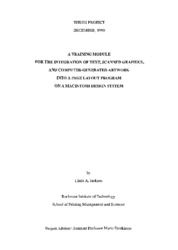| dc.description.abstract | The purpose of this study is to develop a training module for integrating text, artwork, and
graphics into a page layout program. Currently, the information for successful integration
must be referenced from several sources. By having the key elements of integration in one
volume, users attempting to layout and/or design a publication using these programs will
be able to proceed quickly with fewer technical problems.
Rapid growth is predicted for computer-based tools in graphic design studios,
advertising agencies, and magazines which normally use computer design stations. These
computer design stations require proper training to be used cost effectively. Consequently,
training is important for firms investing in them.
For the types of publications produced by graphic design studios, advertising
agencies, and magazines, training is recommended by the author in the following five
areas: word processing, artwork, graphics, page layout, and integration of programs. The
manuals available for the individual programs were found to be adequate except in the area
of integration. The information was spread out over several manuals and tended to assume
more than entry level knowledge of computer vocabulary.
The goal of this project is to bring the integration information together into one
resource. Each stage of integration will be explained for a user who is not computer
literate. It is necessary to specify programs for the integration training module since
different programs have different requirements for integration. Programs were selected
based on popularity, extensive use, and technical competence in the graphic arts industry.
This project is comprised of two components. The first and major phase of the
project is the experimentation, research, and writing of the integration training module.
The final product will be an integration training module in the form of a reference manual.
Research and experimentation will determine the specific contents and instructions for
each chapter.
The second component is the evaluation and subsequent revisions. A panel of
judges will be asked to use the integration training module. The judges will then evaluate
the module by completing a questionnaire designed to evaluate accuracy, clarity, ease of
use, and usefulness. After reading the evaluations, revisions will be made to the module. | en_US |

